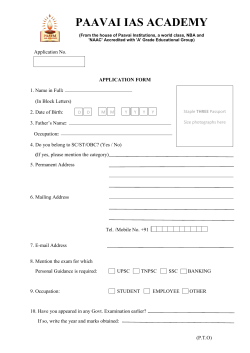
The Adoption of International Financial Reporting Standards What
The Adoption of International Financial Reporting Standards What do you need to know? 1. Similarity to Canadian GAAP 2. Dates of implementation 3. Structure of Information – where to find it IFRS vs. Canadian GAAP The overriding Principles and Conventions of IFRS are laid out in a document entitled, ‘Framework for the Preparation and Presentation of Financial Statements’. Some key points of the framework include: Qualitative Characteristics of Financial Statements Qualitative characteristics are the attributes that make the information provided in financial statements useful to users. The four principal qualitative characteristics are understandability, relevance, reliability and comparability. Understandability Readily understandable by users with reasonable knowledge and a willingness to study the information with reasonable diligence. Relevance Information is relevant when it influences the economic decisions of users. Reliability Information is reliable when it is free from material error and bias and can be depended upon by users to represent faithfully that which it attempts to represent. Comparability Users must be able to compare financial statements of an entity through time; thus, transactions must be accounted for in a consistent way over time and throughout an entity. IFRS – By Section Number IAS 1 – Financial Statement Presentation IAS 2 – Inventories IAS 7 – Statement of Cash Flows IAS 8 – Accounting Policies, Changes in Estimates, and Errors IAS 10 – Subsequent Events IAS 11 – Construction Contracts IAS 12 – Income Taxes IAS 16 – Property, Plant, and Equipment IAS 17 – Leases IAS 18 – Revenue IAS 19 – Employee Benefits IAS 20 – Accounting for Government Grants IAS 21 – Accounting for Foreign Exchange IAS 23 – Borrowing Costs IAS 24 – Related-party disclosures IAS 26 – Retirement Benefit Plans IAS 27 – Consolidated and Separate Financial Statements IAS 28 – Investments in Associates IAS 29 – Hyperinflationary Economies IAS 31 – Joint Ventures IAS 32 – Financial Instruments – Presentation IAS 33 – Earnings per Share IAS 34 – Interim Financial Reporting IAS 36 – Impairment of assets – IFRS allows reversal of IFRS IAS 37 – Provisions, contingent liabilities and assets IAS 38 – Intangible Assets IAS 39 – Financial Instruments – Recognition and Measurement IAS 40 – Investment Property IAS 41 – Agriculture IFRS 1 – Adoption of IFRS IFRS 2 – Share-based Payment IFRS 3 – Business Combinations IFRS 4 – Insurance Contracts IFRS 5 – Non-current Assets Held for Sale and Discontinued Operations IFRS 6 – Exploration for and Evaluation of Mineral Properties IFRS 7 – Financial Instruments - Disclosures IFRS 8 – Operating Segments IFRS 9 – Financial Instruments GAAP / IFRS for Grade 11 and Grade 12 Accounting Column one is a list of GAAP from Syme’s Accounting One textbook. Column two is where the similar concept occurs under IFRS. Column three is an explanation that one could use in a Grade 11 and 12 classroom. Canadian GAAP Conservatism IFRS Equivalent Reliability – Prudence Consistency Principle (Framework para. 37) Comparability (Framework para. 39) Cost Principle Measurement Full Disclosure (Framework para. 100) Completeness Going Concern (Framework para. 38) Going Concern (Framework para. 23) Materiality Relevance – Materiality Objectivity (Framework para. 29) Reliability - Neutrality Revenue Recognition (Framework para. 36) IAS 18 – Revenue Business Entity Time Period Matching – n/a Not found. Not found. n/a Description Prudence is a degree of caution in making judgements such that assets or income are not overstated and liabilities and expenses are not understated. The measurement and presentation of transactions must be carried out in a consistent way throughout an entity and over time for that entity. If methods change, users must be informed as to the impact of the change. In most circumstances, assets are recorded at the amount of cash or cash equivalents paid at the time of their acquisition. To be reliable, financial information must be complete, as an omission can cause information to be false and misleading. The financial statements are normally prepared on the assumption that the entity will continue in operation for the foreseeable future. Hence, elements remain at their cost, not adjusted to their liquidation value. Information is material if its omission or misstatement could influence the decisions of users. Thus, all material information must be reported. To be reliable, the information contained with the financial statements must be neutral, that is, free from bias. Revenue shall be measured at the value of the consideration received or receivable. Transactions are recognized when they occur not when cash is paid. n/a n/a Matching no longer exists under Canadian GAAP.
© Copyright 2025









